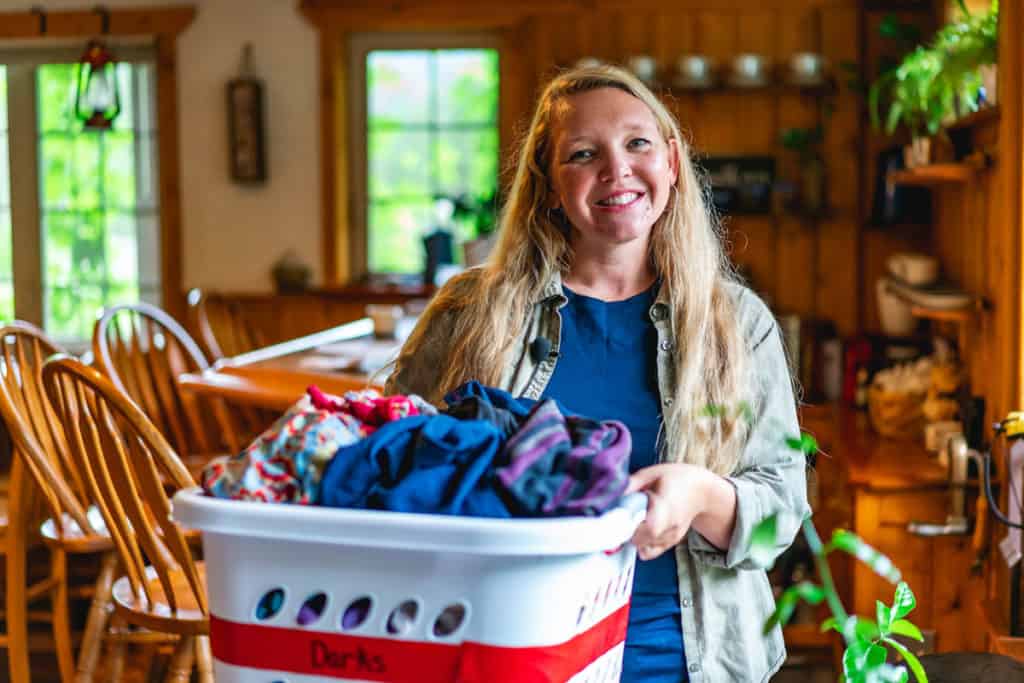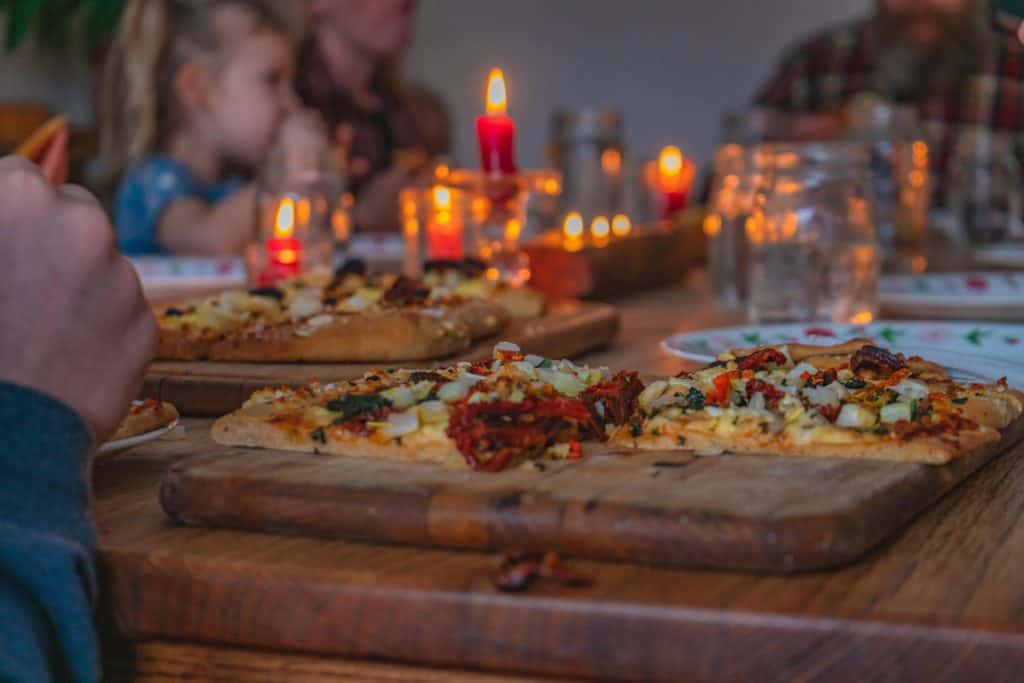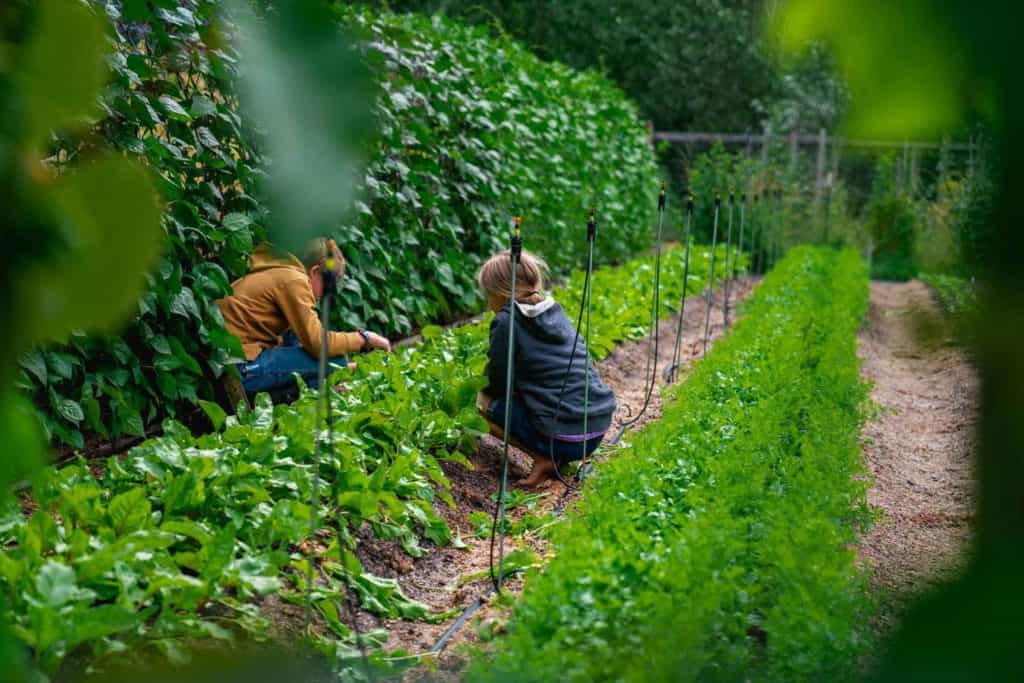Implementing a daily routine for kids is best when there is structured time yet flexibility to allow for a healthy balance to respond to the fluctuations of the homesteading lifestyle. Homesteading with children does not need to feel chaotic, nor must you adhere to a rigid daily schedule and become a slave to a daily routine chart. Read on to learn how we provide this flexible structure for our children, from toddlers to teenagers.

Our Daily Routine For Kids
Learning to manage a homestead requires an intentional effort that, for us, has paid off in big dividends over the years.
In the past, I have shared my morning routine, how I plan morning chores for children, the importance of chore time for kids, and how we utilize the homestead as an educational tool when homeschooling our children.
These separate activities come together into a productive daily routine that allows us to work together as a family unit to accomplish what needs to be done.
There are times when we need to learn to pivot when things go wrong on the homestead, and there are those times we adjust to welcomed changes, like preparing for a new baby. Whatever comes our way, remaining flexible is the key to resilience and peace.
Our daily routine is broken down into a few categories:
- Table Time
- Jurisdictions
- Laundry Time
- School Time
- Nap Time
- Free Time
- Dinner
Table Time
Mornings are a special time for our family. The first set of chores begins around 7:00 AM after rising by 6:30 AM.
Some of us get up earlier so we can have personal quiet time, and then get out and start the first set of chores for the day so we are ready to meet for table time and breakfast around 7:30 AM.
We value the importance of a healthy breakfast and enjoy coming together around the kitchen table, focusing on relationships, sharing a life lesson, or teaching a simple truth that leads to character-building for our children.
We usually spend about 45 minutes sitting together, having breakfast, and then transition to our next chore set.

Jurisdictions
We value spending time together and finding ways to make chore time enjoyable instead of burdensome. The system of chore jurisdictions is a tool that works well for our family. Each facet teaches them a new skill that will benefit their lives.
Starting when they are young and giving them age-appropriate tasks sets them up for success and accomplishment as they age. Chore jurisdictions are our next set of chores for the day.
These are standard chores for the main rooms we all share in the house, divided by an area assigned to each child every day of the week and one child who overlooks the work and ensures it gets done correctly.
The overseeing child lets me know if work is questionable, and I will make the necessary corrections and instructions.
Things can get messy in no time, but they also get cleaned up quickly and efficiently. The kitchen is the most used room in the house, so that is a shared responsibility throughout the day.
Bedrooms and personal space are each child’s daily responsibility. Then it’s laundry time!

Laundry Time
Laundry for a household of thirteen or more people can seem overwhelming if we don’t keep up with our laundry strategies daily. This system works for large and small families and helps us stay caught up instead of always trying to catch up.
Once there are clean clothes to be folded, I read out loud to our children while they collectively sort and fold the laundry together. The toddlers are beside me, practicing sitting still, while the older kids sort, fold and put away.
Often, the older children help direct the younger ones with an age-appropriate task they can do, like putting kitchen or bath towels where they go. They are preparing for more responsibility in the future.
It is a good method for our family because we enjoy listening to a story while accomplishing something that we all benefit from: clean clothes, towels and bedding. Chores don’t have to be tiresome; we try to make it a shared family experience that is relational and fun!

School Time
Once it’s school time, our family has been up for several hours; we’ve had breakfast and family time, the house is tidy, everyone’s laundry is done, and it’s time to start our schoolwork. It’s around 9:30 AM, and we have about three hours until lunchtime.
When it’s a school day, we prepare what’s needed, gathering books and materials. Homesteading Hack: If you are new to homeschooling, my homeschooling tips will help you get started.
When it’s a homesteading day filled with canning a big harvest from the garden, we prepare for that task.
School days are lined out for each child; they focus on where they are and what they need to accomplish, and I make myself available for instruction or correction. We also take a couple of short breaks in between so the children can go outside and get some air and stretch.
We do another quick clean-up, putting school supplies away and straightening up the needed areas before moving on to lunchtime. This is when each child (except for the younger ones) gets their lunch and takes an hour of free time, eating, playing or doing another approved activity.

Nap Time
Nap time is when the younger children go down for a nap, and the rest of us straighten up the kitchen area after lunch. Then, there is a quiet time in the house for a couple of hours. I train all my children at a young age to nap consistently daily.
Nap time is important for the whole family to take a break and have some quiet time. If the older children have homework, want to work on a project, or play outside, now is the time. I require it to stay quiet so the little ones aren’t disturbed during a much-needed naptime.
Homesteading while pregnant has its challenges, one of them is fatigue. Moms know the importance of getting off our feet and taking a break. This is a great time for Mom to get some office work accomplished and plan specific tasks on the homestead or nap if needed.

Free Time
We transition to free time until it’s time to prepare for dinner chores, around 5:00 PM. The children can work on anything they have going on or spend time outside playing and tending to their interests.
I love activities where my kids are learning and playing simultaneously. You can offer this DIY bubble solution, fun apple stamps, or homemade edible playdough to stimulate their creative play.
Our evening chore set, where we accomplish the tasks of tending to the animals, preparing food in the kitchen for dinner and anything else required, gets done before dinnertime. For us, dinnertime is around 6:00 to 6:30 PM.
We try to pay attention to the chore set time before dinner so we can join together for our evening meal. Everyone starts to get hungry around 5:00 PM, which lets them know to kick it into high gear and accomplish their evening chore duties.

Dinner
The dinner hour is when our family comes together, and we talk about the day’s activities and what’s coming up in the days ahead. After the meal, if it’s still summer and the days are longer, we go outside and enjoy the evening before bedtime routines begin.
We clean the kitchen as we cook, freeing us to enjoy activities together after dinner. Meal planning on the homestead and knowing how to get three home-cooked meals on the table daily keeps the kitchen and mealtimes running efficiently.

Household Management Class
Now that you have looked into what a full day with children looks like on our homestead, are you inspired to take your household management skills to the next level? Consider joining my Household Management Class.
In this masterclass, you’ll learn how to turn your household chaos into household peace. It includes 17 complete video lessons, my make-ahead breakfast casserole recipe eBook, and my household planning sheet printables.

Other Articles You May Enjoy
- What is Homesteading?
- Tips for Homesteading With Children
- Homestead Activities for Winter
- Weekly Chore List on the Homestead
- The Importance of Chore-Time for Kids
- Preparing for a New Baby on the Homestead
- How I Manage Our Home (Household Management Series)
- Educating Children Through Homesteading
- Morning Routine for a Productive Day
- Chore Jurisdictions
- The Importance of a Healthy Breakfast
- Teaching Our Children To Have a Productive Morning


















